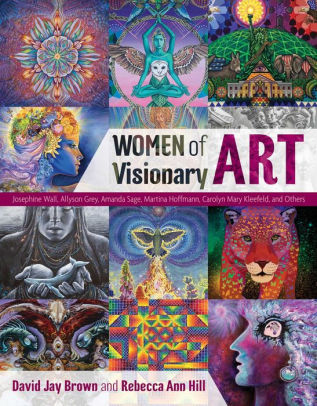Visionary art is a genre that attempts to capture the extraordinary imagery that often comes while under the influence of hallucinogenic plants, drugs, and fungi. These images are characterized by a sense of movement, continuously morphing, and have a sense of three dimensions. They are often complex intricately detailed brightly hued and can have almost textural levels of geometry. As with Surrealistic or Fantastic artwork, Visionary artists draw upon the abundant variety imagery in the unconscious mind as a source of their inspiration. What distinguishes Visionary art from surrealism is the strong sense of spiritual and personal meeting and insight incorporated into the work. Women of Visionary Art is a full color illustrated book of interviews with 18 women artists. In it, Brown, a writer and former neuroscience researcher, and Hill, an illustrator and visionary artist herself, explore common themes with the artists in their interviews, including psychedelic use, dreams, painting techniques, and how womanhood influences their artwork. This is an important work, long overdue.
Another way to refer to these images as is as psychedelic art, but not all of the artists use psychedelic substances to create their art -- at least two were instead inspired through dreams and daydreams. Perhaps the most surprising aspect is how much in common the women had and the connections between them shine through in their stories.
There has certainly been a huge influx of visionary art over the past 10 or 20 years, but I see it as stretching back to something ancient, an old tradition of capturing shamanic or visionary experiences. We have in our book art that goes back for thousands of years to the cave wall paintings of France, images that look like people transforming into animals and animals transforming into people. These cave paintings give us some type of inkling about the origins of visionary art, but modern visionary art as we know it grew out of surrealism and psychedelic art and some of the earlier art movements in the 20th century.
Opening with a preface by co-editor Rebecca Ann Hill, the work is followed by a concise and yet excellent introduction to the history of visionary art by co-author David Jay Brown. Then follows gorgeous, exquisite, wonderful, exciting, and inviting interviews with 18 female artists in the Visionary art genre. There are artists here that you think you recognized, or perhaps do recognize such as Josephine wall, but each and every one of them is a captivating and fascinating interview -- no short quotes here! The interviews read as if you are invited to participate in a conversation among equals. Each chapter is packed with full-color images to fall into. The book ends with a list of recommended reading and a bibliography that's well done and an index.
As just a quick sample from the interviews, Allyson Grey has been working in various aspects of art since receiving her MFA in 1976. She notes that humans have been painting “…from their mystic eye” since the dawn of our species, and that “Visionary identifies the sacred inner world of the artist.” Amanda Sage, whose seed motifs have been entering the world since 1999, shares how she deal with creative stagnation: “...what helps me is to move my body first. Opening the body helps open the mind and heart…. This is incredibly grounding, and before you know it you will find that you have lost track of time and are back in the groove of arting. [sic]” Penny Slinger’s work as an illustrator might be known to readers through her very popular Tantra manual Sexual Secrets: The Alchemy of Ecstasy or her Secret Dakini Oracle deck. She says, “I like to use technique, but always in the service of vision. Of course, and using technique, accidents happen and that's all part of the magic too.“
The artists share their techniques, inspirations, and setbacks along with years of accumulated wisdom. This is no mere coffee table book, but a vital link in the chain of women’s wisdom.
~review by Lisa Mc Sherry
Authors: David Jay Brown and Rebecca Ann Hill
Inner Traditions, 2018
pp. 384, $50

